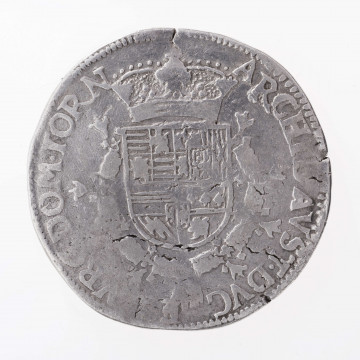
1/2 patagon of Albert and Izabella
1598 — 1621
National Museum in Lublin
Part of the collection: Treasure of the 16th–17th c. coins from Józefów on Vistula
The economic development of Europe in the second half of the 15th century created a demand for silver coins of high value, which as an equivalent of gold ducats could meet the challenges of trade, linking Asia with Europe and the Americas. The raw material for mass production was provided by rich deposits of silver discovered in Europe, and especially in the Spanish colonies in South America.
In Europe the first such coins were made in Tirol (1486) and in Saxony (1500). Making use of the local abundant silver deposits, their production was launched in 1518 in the Czech Ore Mountains in the Schlick county, in the village of Sankt Joachimstahl. From there they were called ‘Joachimstalers’ or abbreviated to ‘thalers’, a term which stuck to the thaler issues in neighbouring countries. These coins were minted under various names in many countries of the world. In England these were silver crowns, in South America eight-inch thalers were minted, in Turkey ‘gurus’, and in the Spanish Netherlands ‘ducatons’ and ‘patagons’.
The ‘patagon’ in question is a thaler issue of the Spanish Netherlands, introduced in 1612 by Albert and Elizabeth (1598-1621) and continued by their successors until the early 18th century. By way of trade these coins came to Poland, where they were called cross thalers – from the image of an oblique cross on the reverse, or albert thalers – from Albert and Elisabeth, the initiators of their emission. Out of more than a dozen kinds of money minted in South Holland, ‘patagons’ and their fractions (halves and quarters) were the only denominations which circulated within the territory of the then Republic of Poland. The largest influx of ‘patagons’ to our lands is recorded in the 2nd half of the 17th century, which is evidenced by their large representation in the hoards of coins hidden at that time. It also indicates the importance of the money in the economic life of our country.
The presented specimen is part of a hoard of 83 thaler coins hidden after 1708 in Józefów, the Biłgoraj region (the Lublin voivodeship). More than a half of this group is made up of ‘patagons’ from the Spanish Netherlands.
Although the silver content of the ‘patagon’ was slightly lower than that of the Polish thalers, they were estimated to be on a par with domestic issues and full-value foreign thalers.
Tomasz Markiewicz
Author / creator
Dimensions
cały obiekt: diameter: 30 mm
Object type
numismatic
Technique
stamp minting
Material
silver
Creation time / dating
Creation / finding place
Owner
The National Museum in Lublin
Identification number
Location / status

1598 — 1621
National Museum in Lublin

1598 — 1621
National Museum in Lublin

1598 — 1621
National Museum in Lublin
DISCOVER this TOPIC
Castle Museum in Łańcut
DISCOVER this PATH
Educational path